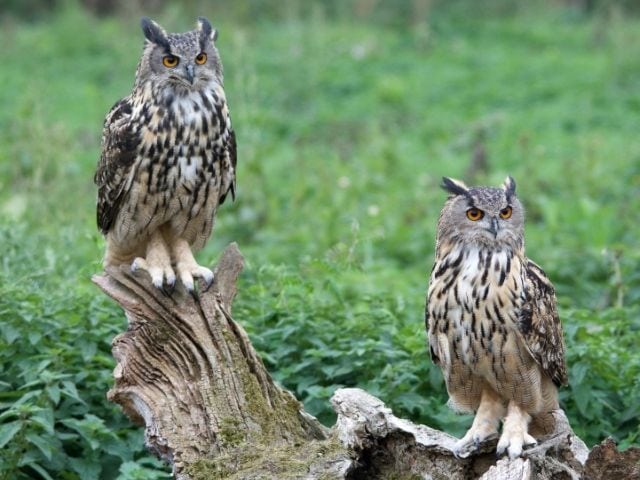Owls are beautiful and fascinating birds with dreamy bulgy eyes and an unusual calm that I cherish.
And yet...
Somehow, I always have to argue with friends (even birdwatchers) and family that they aren't symbols of bad luck or cursed animals. Gladly, you’re here, trying to learn to identify or find these owls in Ohio. So, I feel less like a weirdo.
Now, I'll get to the point without further ado.
Introducing The Eight Owls of Ohio
1. Great Horned Owl
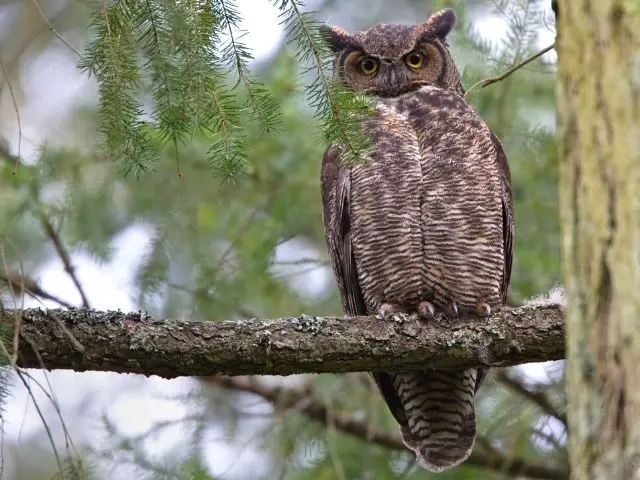
- Length: 18.1 to 24.8 inches
- Wingspan: 39.8 to 57.1 inches
- Weight: 910 to 2500 grams
The great horned owls are the largest resident owls in the Buckeye state. They're mostly found in open woodlots but also in farmlands, forests, and cities.
Apparently, these avian predators thrive anywhere they find themselves using their size and aggression for survival. For example, Great Horned Owls chase out other raptors in their territory and sometimes make them dinner.
Another Ohio owl, the Barred Owl, impulsively moves out if he discovers a great horned owl in the area.
Great Horned Owls generally have a diet consisting of mice, reptiles, small mammals like rabbits, and groundhogs. But up in the Midwest, they also take a likeness for birds, up to the size of a goose!
Almost anything insight is up for grabs, even the stinky skunk. Fortunately, they don't smell as well as they can hear or see.
Great Horned Owls have a tuft of feathers on their head, which gives them their title as "horned." But they serve no auditory purpose - or any really -- other than for camouflage.
The Hoot Owl, as they are also called, because of their deep hoot sounds. However, like other owls, they also bark, scream, whistle, or shriek.
- Voice: hoo-hoo-hoo
- Best location: Everywhere!
- Preferred habitat: Woodlots with open fields for hunting
2. Short-Eared Owl
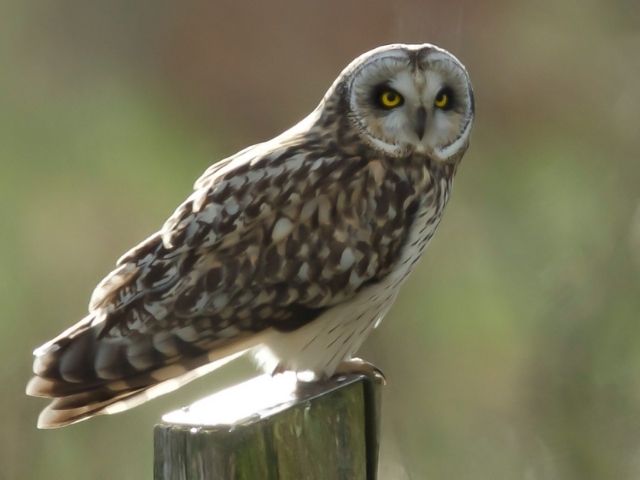
- Length: 13.4 to 16.9 inches
- Wingspan:33.5 to 40.5 inches
- Weight: 206 to 475 grams
Short-eared Owls are sporadic winter visitors in Ohio and breed in Canada. These owls prefer undisturbed meadows, grasslands, and tundras which the state lacks.
Unlike any other owl, short-eared owls are terrestrial or spend most of their time on the ground. They build in between tall grasses or under shrubs using soft grasses and downy feathers. It's rare to find one in a tree.
Interestingly, they hunt mainly in broad daylight but also at night. They take their time to circle prey in between dense vegetation before making the pounce. By the way, meadow voles are their favorite.
As a parting tip, short-eared owls occupy the same habitat as northern harriers. Also, you stand a better chance of spotting one in the northeastern part of the state, like Wyandot County.
- Voice: Hoots (not vocal)
- Best location: Tundras, meadows, and marshes (Killdeer Plains Wildlife Area)
3. Barn Owl
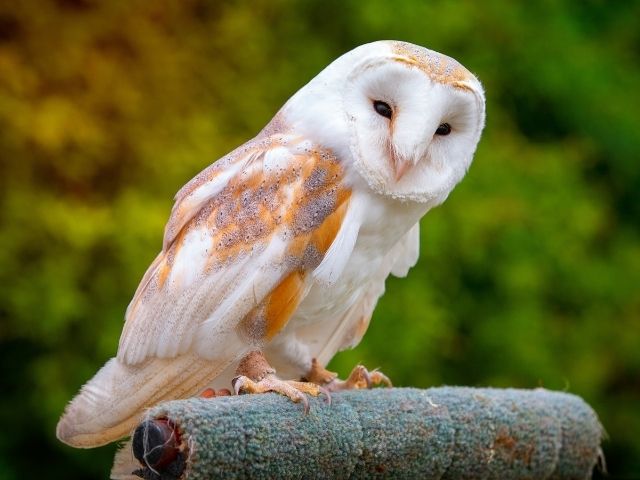
- Length: 12.6 to 15.8 inches
- Wingspan: 39.4 to 49.2 inches
- Weight: 400 to 700 grams
Barn Owls are Ohio natives that stay all through the year. Actually, these owls never wander far off from their range. So, if you find one, best believe you'll be seeing it for years to come.
Barn owls have a ghostly white heart-shaped face and buff-colored plumage. They look like a phantom under the beam of a flashlight (which is the most likely way you'd see one).
In eerie character development, barn owls screech like a banshee when in flight. Also, they take up residence in caves, cavities, and abandoned buildings, such as barns (hence, their name).
Fortunately, you can support the course if you have the habitat. Install a nest box inside a barn or an abandoned building with 3 meters above-ground clearance.
- Hoot: Trilling Loud screech
- Best location: Southern Ohio
- Preferred habitat: Farmlands
4. Eastern Screech Owl
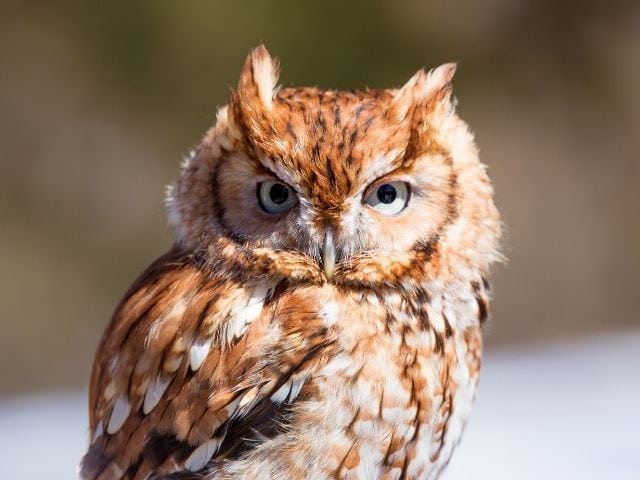
- Length: 6.3 to 9.8 inches
- Wingspan: 18.9 to 24.0 inches
- Weight: 121 to 244 grams
Eastern Screech Owls are the most popular Ohio owl and arguably the smallest you'll ever see (the smaller Northern Saw-whet is a rarity). But these little buddies live in crowded cities, farmlands, villages, and remote forests.
These minuscule avian predators have mastered the art of camouflage and only give themselves away easily by sound.
This little Ohio owl sounds like a baby banshee when it sings its famous trill, called the "bounce song." And it also whines when defending its territory. But good luck finding where the sound comes from.
If you're lucky, a mob of songbirds might reveal a roosting screech owl during the day.
Not only do they resemble, but they're also fierce predators for their size. These nocturnal raptors hunt anything small and tasty, from insects to reptiles and small mammals.
Notice one in your neighborhood? Screech owls would readily occupy nest boxes set up in the right place and at the right time.
- Hoot: Trilling “bounce song”
- Best location:
- Preferred habitat: Tree cavities in woodlots, parks, orchards, and gardens
5. Barred Owl
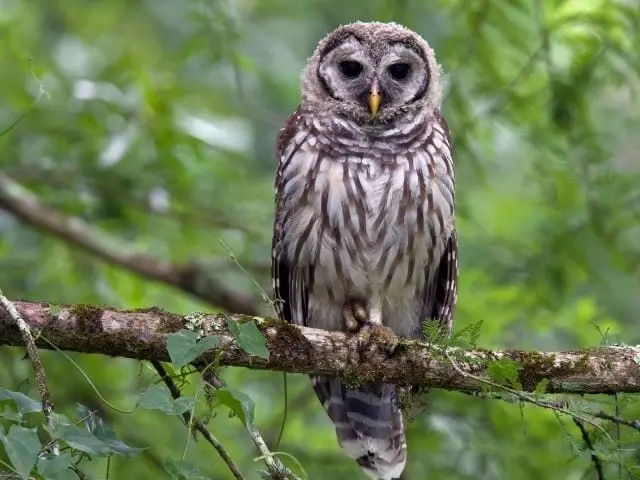
- Length: 16.5 to 25 inches
- Wingspan: 38 to 49 inches
- Weight: 500 to 1250 grams
True to their name, these owls have a barred pattern of mostly gray feathers and no ear tufts. In short, they're easy to distinguish.
Well, that's if you see one. Learn their smash hit song "Who-cooks-for you- who-cooks-for-you-all" and you'll never miss them.
But it's not a friendly appearance, so you should probably use a speaker that's not in your hands.
Barred Owls are permanent residents of our old-growth forests and riparian (near water) woodlands. They might be dangerous predators in their own right but are easy meat for Great Horned Owls.
Also, they are shy owls known to abandon their nests at the slightest disturbance. So, please don't be the bad guy that intrudes.
- Hoot: "Who cooks for you" song
- Best location: Forests with beech trees
- Preferred habitat: Woodlands of 100+ acres extent
6. Northern Saw-Whet Owl
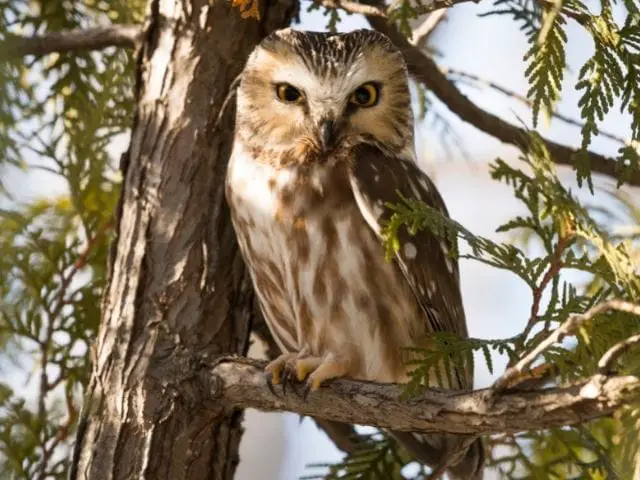
- Length: 7.1 to 8.3 inches
- Wingspan: 16.5 to 18.9 inches
- Weight: 65 to 151 grams
Northern Saw-Whets are the smallest owls in the state and the most adventurous. Many stop by on their migratory flight down south, but some stay put in Ohio.
As you'd expect, they are hard to see. These cute little owls, though they try their best to look fierce —roosted within a tree or inside a woodpecker cavity.
Look out for them in Ohio in dense coniferous shrubs and trees near a water body. These fluffy balls particularly like to stay at eye-level near the trunk of trees. They would sit still and silently while they watch as they fool you with camouflage. But it's a safety measure.
"I've seen a dozen Saw-whets in the wild, but probably thousands have seen me," says Kenn Kaufmann, an Ohio-based wildlife expert.
These owls can be seen even in crowded city parks, contrary to the popular belief that they're rare.
The best region to see them is in Northwestern Ohio, Cleveland, and around Lake Erie.
- Hoot: “too-too-too” hoot
- Best location: Lakefront Nature Preserve
- Preferred habitat: Coniferous trees and shrubs
7. Long-Eared Owls

- Length: 13.8 to 16 inches
- Wingspan:'35 to 39.4 inches
- Weight: 220 to 39.4 inches
Long-eared Owls are highly secretive winter Ohio owls. These owls not only hide in dense foliage but also do not call or hoot frequently.
So, like Saw-whets, Long-eared Owls are probably only rarely seen and not exactly a rare species in the state. Ironically, medium-sized owls even roost in groups when they winter here.
Yet, most Ohio birders, even experienced ones, have only ever spotted the Long-eared owl in one location - at the pine stands of Killdeer Plains Wildlife Area. Well, it's hard for wintering raptors to pass up their rodent population.
Incidentally, Long-eared Owls get their name from their long-ear tufts but don't confuse them with Great Horned Owls. They are much smaller and lankier. Also, their faces and long ear tufts give them a distinguishable cat-like appearance.
- Hoot: soft hoots and cat-like whine (not vocal)
- Best location: Killdeer Plains Wildlife Area
- Preferred habitat: shelterbelts, groves, and thickets
8. Snowy Owl
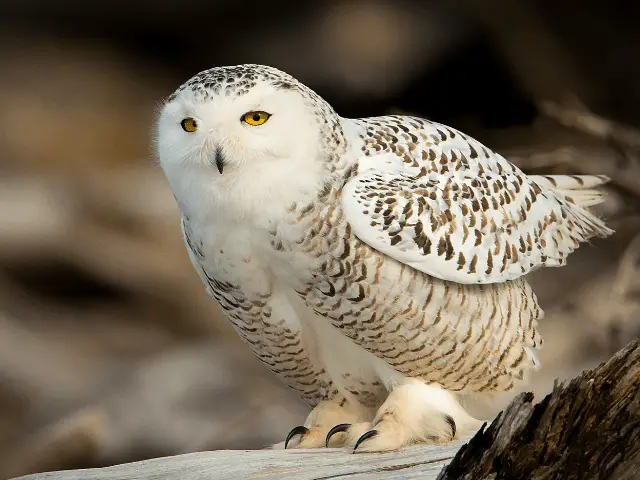
- Length: 20.5 to 27.9 inches
- Wingspan: 49.6 to 57.1 inches
- Weight: 1600 to 2950 inches
Snowy owls are the rarest owls to see in Ohio.
They breed in the Arctic Tundra and winter throughout Canada. And sporadically across the US in irruptive years. This happens about once in four years, and a handful, sometimes hundreds, may inhabit open country areas in Ohio.
Luckily, they stay out in the open for all to see during their stay.
While they primarily hunt lemmings in their breeding ground, wintering snowy owls have a wide menu that includes voles, geese, and other birds.
- Hoot: raspy hoots
- Best location: Lake Erie (uncertain)
- Preferred habitat: Shorelines, agricultural fields (in Ohio)
Frequently Asked Questions About Ohio Owls
What is the Largest Owl in Ohio?
Great Horned Owls are the largest owls found in Ohio. They stand at about 3 feet tall and spread an imposing wingspan that reaches almost 5 feet in male adults.
How big do owls get in Ohio?
There's a wide variation in size among Ohio owls. The state is home to some of the largest owl species, such as Great Horned Owls and sometimes, the bulkier Snowy Owls. Mid-sized owls like Barred Owls, Long-eared Owls, and Barn Owls also live in the state. Ohio also hosts miniature robin-sized owls, like the Screech Owls and North Saw-whet Owls.
Are Owls Common in Ohio?
It depends. In total, eight owl species inhabit the Buckeye state but most of them will be primarily heard than seen. However, if you're searching, you will have some luck.
What Kind of Owls are in Ohio?
The eight types of owls found in Ohio are:
- Great horned owl,
- Barn owl
- Eastern screech owl
- Barred owl
- Short-eared owl
- Long-eared owl
- Snowy owl
- Northern saw-whet owl
Watch this video from Cornell Lab of Ornithology about the unique characteristics of Eastern screech owls:
When do Owls Nest in Ohio?
The great horned owls are the first nesters and start laying eggs as early as January. However, the rest of the owls breeding in Ohio won't start nesting till around March and April.
Wrapping Up
There you have it, the eight beautiful owls in Ohio. With your newfound awareness of their sounds and behavior, you might discover one near you soon enough. Or you could take an adventure hike into the many parks across the state to find one yourself. It's always a great feeling to have that first stare with the one you found by yourself.
Which species have you heard of or spotted in your neighborhood?

